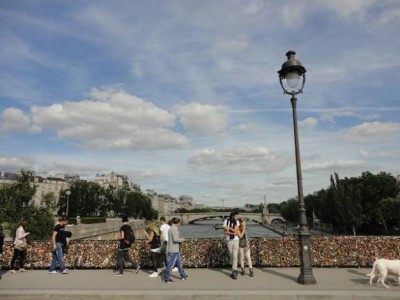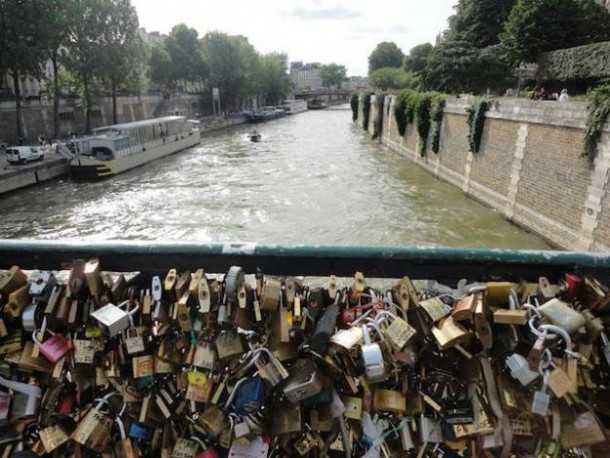PARIS, FRANCE. As I walked away from Notre Dame, I found myself at the Pont Marie Des Arts Bridge gazing at a couple sealing a kiss while placing a lock on the bridge. As someone who truly admires the architectural settings in Paris, I find it astonishing to infer how architectural monuments in the past mainly gave off messages for war, political agendas, memorial remembrance, religious ideals etc., and now, the same monumental structures are shedding a new light of everlasting love. Lovers from around the globe come to Paris to fabricate their own testimony of love, by drinking wine under the Eiffel tower, having romantic dinners on the Seine river, picnic in the Luxembourg Garden, and so forth… One unique tradition, is placing padlocks on the bridges and engraving initials on the padlocks then tossing the keys into the Seine river to declare the endless devotion. Although this traditional phenomena is not only found in Paris, but in some major cities in the world as well.
According to ABC News, the legend surrounding the bridge and the padlock tradition began “when a schoolmistress named Nada would meet her lover, a[n] army officer named Relja, on the bridge where they pledged their love in the days before World War I.” The proceeds to explain the tradition as follows: “The soldier went on to fight the Germans at the Thessaloniki front in Greece, where he found a new love and married her. Nada is said to have died of sadness and grief. Nada’s tale of grief inspired young couples determined not to abandon one another to begin writing their names on padlocks and chaining them to the fence of the bridge where Nada and Relja swore their devotion.

Pont d’Alma | Jehan Jawd
Different sizes, designs, and colors of locks fill up every space of the bridges to create an artistic illusion that sets an admiring tone symbolizing the desire for love. But, to my surprise, the padlocks on the bridges in Paris is not an old tradition. The locks started to appear sometime in the early 2000s. In May 2010, Paris Town Hall expressed concern over the growing number of love-locks, saying: “they raise problems for the preservation of our architectural heritage”. Shortly after, all the padlocks disappeared, and were reportedly taken down by the government. Lovers have shown their refusal to let this new tradition die down by building up collections once more, this time on Pont de l’Archevêché. Romance beats politics. Although I do understand the government’s concern in “preserving the architectural heritage,” but I think these new traditions surrounding romantics justifies Paris’ nickname as the “City of Love” and gives a new meaning to historic monuments. Walking through the bridges makes me appreciate artists dedication to this city and their tracings in painting a galore of sceneries, and composing classical music to set the background mood. These traditions of romance found in monuments transcends to the locals and attracts visitors from all over to be part of a magical experience.
— Robert Jehan Jawd

